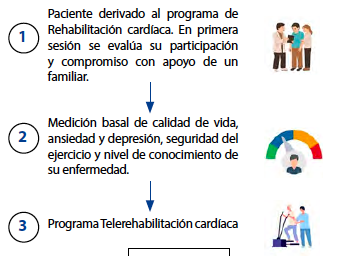Cardiac tele-rehabilitation in times of pandemic. Experience at the National Cardiovascular Institute INCOR in Lima-Peru
DOI:
https://doi.org/10.47487/apcyccv.v4i1.281Keywords:
Cardiac Rehabilitation, Coronavirus Infections, Telemedicine, Cardiovascular DiseasesAbstract
Objective. Cardiac Rehabilitation (CR) programs based on telehealth are an alternative in the context of a pandemic and represent an opportunity to continue in the intervention of cardiovascular diseases (CVD). The present study aims to evaluate the effect of a Cardiac Tele-Rehabilitation (CTR) program on quality of life, anxiety/depression index, exercise safety and Level Of disease awareness in patients discharged from a national referral institute in times of pandemic. Methods. A pre-experimental study in cardiac patients who entered the cardiac rehabilitation program at INCOR from August to December 2020. The study included low-risk patients who were administered a questionnaire (on cardiovascular disease, exercise safety, anxiety/depression, and quality of life) at the beginning and end of the program, which was applied through a virtual platform. Descriptive and comparative before-after analysis was used through hypothesis testing. Results. Sixty-four patients were included (71.9% male). The mean age was 63.6 ±11.1 years. Regarding exercise safety, an increase in the mean score was found after the application of the program (3.06 ± 0.8 to 3.18 ± 0.7, p=0.324). Concerning anxiety, the mean score was reduced from 8.61 to 4.75, while for depression, the reduction was from 7.27 to 2.92. Regarding the quality-of-life score, the global component improved from 111.48 to 127.92. Conclusions. The CTR program implemented through a virtual platform during the COVID-19 pandemic enhanced quality of life and decreased stress and depression in cardiac patients discharged from a national cardiovascular referral center.
Downloads
References
Fernández Coronado RO, Heredia Ñahui MA, Olortegui Yzu AR, Palomino Vílchez RY, Gordillo Monge MX, Soca Meza RE, et al. Reducción del riesgo cardiovascular en trabajadores de un instituto de salud especializado mediante un programa de prevención cardiovascular. An Fac Med. 2020;81(1):14-20. doi: 10.15381/anales.v81i1.17328.
Schmid J-P. Telehealth during COVID-19 pandemic: will the future last? Eur J Pre. Cardiol. 2021;28(5):522-3. doi: 10.1093/eurjpc/zwaa016.
Hansen D, Rovelo Ruiz G, Coninx K. Computerized decision support for exercise prescription in cardiovascular rehabilitation: high hopes…but still a long way to go. Eur J Prev Cardiol. 2021;28(5):569-571. doi: 10.1093/eurjpc/zwaa105.
Satyamurthy A, Prabhu N, Padmakumar R, Babu AS. Feasibility of an exercise-based cardiac rehabilitation algorithm in patients following percutaneous coronary intervention for acute coronary syndrome. Indian Heart J. 2020;72(4):289-292. doi: 10.1016/j.ihj.2020.07.011.
Barison A, Aimo A, Castiglione V, Arzilli C, Lupón J, Codina P, et al. Cardiovascular disease and COVID-19: les liaisons
dangereuses. Eur J Prev Cardiol. 2020;27(10):1017-1025. doi: 10.1177/2047487320924501.
Cordero SJ. Rehabilitación Cardiaca y Prevención. México: PyDESA; 2017.
Scherrenberg M, Falter M, Dendale P. Cost-effectiveness of cardiac telerehabilitation in coronary artery disease and heart failure
patients: systematic review of randomized controlled trials. Eur Heart J Digit Health. 2020;1(1):20-29. doi: 10.1093/ehjdh/ztaa005.
Frederix I, Hansen D, Coninx K, Vandervoort P, Vandijck D, Hens N, et al. Effect of comprehensive cardiac telerehabilitation on one-year cardiovascular rehospitalization rate, medical costs and quality of life: A cost-effectiveness analysis. Eur J Prev Cardiol. 2016;23(7):674-82. doi: 10.1177/2047487315602257.
Gozzer Infante E. Una visión panorámica de las experiencias de Telesalud en Perú. Rev Peru Med Exp Salud Pública. 2015;32(1):385-90.
Casaverde Pineda M, Escate Quijandrìa M. Calidad de vida en pacientes post infarto agudo de miocardio que asisten al programa
de rehabilitación cardiaca en un instituto nacional 2017 [Tesis de especialidad]. Lima, Perú: Universidad Cayetano Heredia; 2018.
Rocha-Márquez RE, Lozano-Rangel O, Romero-Quechol G. Nivel de conocimientos del paciente sobre el cateterismo cardiaco y
presencia de ansiedad y depresión Rev Enferm Inst Mex Seguro Soc. 2017;25(4):257-64.
Salazar TH, López CF, del Río BR, Barreiro LAD. Relación de la depresión, ansiedad y calidad de vida en pacientes hospitalizados
con insuficiencia cardiaca. Psicología y Salud. 2014;24(1):25-34.
Carneiro AF, Mathias LAST, Rassi Júnior A, Morais NS de, Gozzani JL, Miranda AP de. Avaliação da ansiedade e depressão no período pré-operatório em pacientes submetidos a procedimentos cardíacos invasivos. Rev Bras Anestesiol. 2009;59(4):431-8. doi: 10.1590/S0034-70942009000400005.
Esquivel Molina CG, Gámez Castillo JA, Villa Hernández F, García Espino FA, Martínez Mendoza JA, Aguirre Galindo B, et al. Ansiedad y depresión en síndrome coronario agudo. Medicrit. 2009;6(1):18-23.
Bandura A. Guide for constructing self-efficacy scales. In: Pajares F, Urdan T (Eds.), Self-efficacy Beliefs of Adolescents. Greenwich, CT: Information Age Publishing; 2006. p. 307-337.
Ghisi GLM, Sandison N, Oh P. Development, pilot testing and psychometric validation of a short version of the coronary artery
disease education questionnaire: The CADE-Q SV. Patient Educ Couns. 2016;99(3):443-447. doi: 10.1016/j.pec.2015.11.002.
Perez Serrano M, Carlos Nicolas Perez Garcia CNP, Daniel Enriquez Vazquez DEV, Marcos Ferrandez Escarabajal MFE, Jesus Diz Diaz JDD, Noemi Ramos Lopez NRL, et al. Improvement of the heart failure patient process for the prevention of new events through tele-education and continuous tele-optimization of the treatment by nursing staff. Eur J Prev Cardiol. 2021;28(Suppl 1):zwab061.415. doi: 10.1093/eurjpc/zwab061.415.
Everett B, Salamonson Y, Davidson PM. Bandura’s exercise self-efficacy scale: validation in an Australian cardiac rehabilitation setting. Int J Nurs Stud. 2009;46(6):824-9. doi: 10.1016/j.ijnurstu.2009.01.016.
Meland E, Maeland JG, Laerum E. The importance of self-efficacy in cardiovascular risk factor change. Scand J Public Health. 1999;27(1):11-7. doi: 10.1177/14034948990270011001.
Shin YH, Hur HK, Pender NJ, Jang HJ, Kim MS. Exercise self-efficacy, exercise benefits and barriers, and commitment to a plan for exercise among Korean women with osteoporosis and osteoarthritis. Int J Nurs Stud. 2006;43(1):3-10. doi: 10.1016/j.ijnurstu.2004.10.008.
Lavie CJ, Milani RV. Prevalence of anxiety in coronary patients with improvement following cardiac rehabilitation and exercise training. Am J Cardiol. 2004;93(3):336-9. doi: 10.1016/j.amjcard.2003.10.015.
Lavie CJ, Milani RV. Adverse psychological and coronary risk profiles in young patients with coronary artery disease and benefits of formal cardiac rehabilitation. Arch Intern Med. 2006;166(17):1878-83. doi: 10.1001/archinte.166.17.1878.
Yaman Aktas Y, Gok Uğur H, Orak OS. Discharge Education Intervention to Reduce Anxiety and Depression in Cardiac Surgery
Patients: A Randomized Controlled Study. J Perianesth Nurs. 2020;35(2):185-192. doi: 10.1016/j.jopan.2019.08.012.
Herring MP, O’Connor PJ, Dishman RK. The effect of exercise training on anxiety symptoms among patients: a systematic
review. Arch Intern Med. 2010;170(4):321-31. doi: 10.1001/archinternmed.2009.530.
Menárguez VA, Sempere Ripoll JM, Martínez Amorós R. Eficacia de la intervención psicológica en rehabilitación cardíaca. Medicina de Familia. SEMERGEN. 2019;45(5):288-294.
Peixoto TC, Begot I, Bolzan DW, Machado L, Reis MS, Papa V, et al. Early exercise-based rehabilitation improves health-related quality of life and functional capacity after acute myocardial infarction: a randomized controlled trial. Can J Cardiol. 2015;31(3):308-13. doi: 10.1016/j.cjca.2014.11.014.
Madadkar S, Noorian K. Effect of Multimedia Education Based on the Family-centered Approach and Telephone Follow-up (Telenursing) on the Quality of Life of Patients with Myocardial Infarction after Discharge. J Clin Nurs Midwife. 2020;8(4):500-510.
de Melo Ghisi GL, Oh P, Thomas S, Benetti M. Development and validation of an English version of the Coronary Artery Disease Education Questionnaire (CADE-Q). Eur J Prev Cardiol. 2013;20(2):291-300. doi: 10.1177/2047487312437061.

Downloads
Published
Issue
Section
License
Copyright (c) 2023 The journal is headline of the first publication, then the author giving credit to the first publication.

This work is licensed under a Creative Commons Attribution 4.0 International License.














